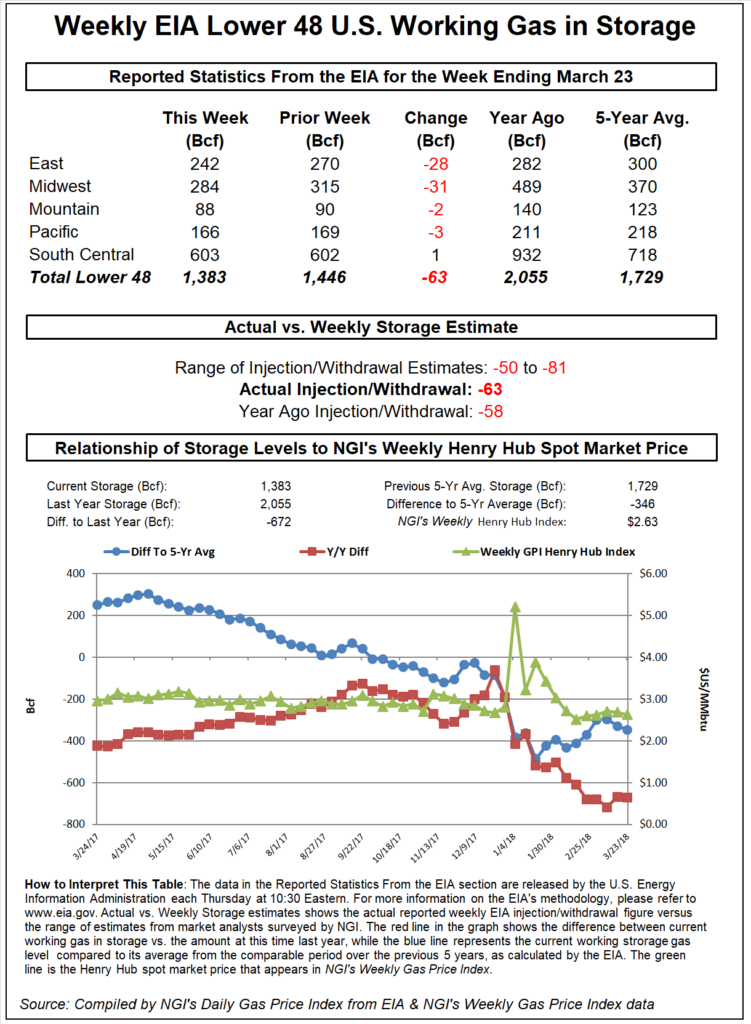Markets | NGI All News Access | NGI Data
Bearish EIA Storage Miss Makes Dent in Natural Gas Futures Rally Supported by Chilly April
The Energy Information Administration (EIA) reported a weekly natural gas storage withdrawal Thursday that missed to the bearish side of market expectations, and futures — trading higher on colder overnight weather trends — pulled back a few cents on the news.

EIA reported a 63 Bcf withdrawal from Lower 48 storage for the week ended March 23, tighter versus the 58 Bcf withdrawn in the year-ago period and a five-year average withdrawal of 46 Bcf.
As the figure crossed trading desks at 10:30 a.m. EDT, the May contract dipped as low as $2.735 after trading above $2.755 minutes just before and as high as $2.764 about a half hour earlier. The prompt month had rallied from Wednesday’s settle following supportive overnight weather data showing colder temperatures lingering in the northern United States longer into April.
By 11 a.m. EDT, May was trading around $2.742, up about 4 cents from Wednesday’s settle.
Prior to the report, the market had been looking for a withdrawal somewhat tighter than the actual figure. A Reuters survey of traders and analysts had on average predicted a 70 Bcf withdrawal from U.S. gas stocks with responses from 50-81 Bcf. OPIS by IHS Markit had predicted a 67 Bcf withdrawal, while IAF Advisors analyst Kyle Cooper also called for a 67 Bcf pull. Intercontinental Exchange futures for the upcoming report had settled at 63 Bcf Wednesday.
Last week, EIA reported an 86 Bcf withdrawal for the period ending March 16.
“This is the fourth week where EIA data was on the looser side of expectations, as data shows the impact of increased production and limited nuclear outages last week,” Bespoke Weather Services said. “On a seasonal basis the print shows structural tightness also easing as production soars.
“An increase in nuclear outages this past week may lend a bit more raw tightness, and adjusted burns still do not seem loose, so today’s price strength is not entirely unwarranted,” the firm said. “However, room for prices above $2.75 seems limited, and once cash strength and short-term weather catalysts ease we should pull back.”
Total working gas in underground storage stood at 1,383 Bcf as of March 23, versus 2,055 Bcf a year ago and five-year average inventories of 1,729 Bcf, according to EIA. The year-on-year deficit increased slightly week/week from 667 Bcf to 672 Bcf, while the year-on-five-year deficit increased from -329 Bcf to -346 Bcf, EIA data show.
By region, the East and Midwest both recorded hefty withdrawals for the period at 28 Bcf and 31 Bcf, respectively. The South Central saw a net injection for the week, with a 3 Bcf injection into nonsalt offsetting a 1 Bcf pull from salt. In the Mountain region, 2 Bcf was withdrawn, while 3 Bcf was withdrawn in the Pacific, according to EIA.
© 2024 Natural Gas Intelligence. All rights reserved.
ISSN © 1532-1231 | ISSN © 2577-9877 |
